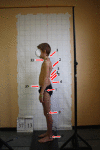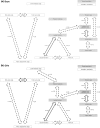A clinical postural model of sagittal alignment in young adolescents before age at peak height velocity
- PMID: 22763558
- PMCID: PMC3481087
- DOI: 10.1007/s00586-012-2416-7
A clinical postural model of sagittal alignment in young adolescents before age at peak height velocity
Abstract
Introduction: From a clinical point of view, knowledge of customary standing positions among healthy young adolescents is of primary importance. The purpose of this study was to document the correlations between sagittal standing posture parameters in a pre-peak height velocity (pre-PHV) cohort.
Materials and methods: This cohort study included 639 pre-PHV boys (age 12.6 [SD, 0.54] years) and 557 pre-PHV girls (age 10.6 [SD, 0.47] years). Gross body segment orientations and spinopelvic orientation/shape indexes were quantified using a clinical screening protocol. Pearson's correlation coefficients were determined for all sagittal standing plane alignment parameters, and a postural model was used to analyze the correlations between parameters.
Results: Both at the gross body segment and spinopelvic level, an interdependence was found between postural parameters. No correlations were observed between 'global' parameters related to the pelvis, trunk or body anteroposterior translation postures and 'local' spinopelvic geometries. A similar pattern and strength of correlations was obtained in pre-PHV boys and girls, except for the reciprocal relationships between the craniovertebral angle and adjacent anatomic segment characteristics and between thoraco-lumbar geometries.
Conclusions: Although the correlation schemes do not imply a causal relationship, the proposed postural model allows conjecture about standing posture to be organized slightly differently in pre-PHV boys and girls. Whereas the standing posture in pre-PHV boys might be organized predominantly according to an ascending mode, bottom-up and top-down organizations appear to coexist in pre-PHV girls.
Figures


Similar articles
-
Classification system of the sagittal standing alignment in young adolescent girls.Eur Spine J. 2014 Jan;23(1):216-25. doi: 10.1007/s00586-013-2952-9. Epub 2013 Aug 18. Eur Spine J. 2014. PMID: 23955370 Free PMC article.
-
Posture class prediction of pre-peak height velocity subjects according to gross body segment orientations using linear discriminant analysis.Eur Spine J. 2014 Mar;23(3):530-5. doi: 10.1007/s00586-013-3058-0. Epub 2013 Oct 7. Eur Spine J. 2014. PMID: 24097292 Free PMC article.
-
Sagittal standing posture and its association with spinal pain: a school-based epidemiological study of 1196 Flemish adolescents before age at peak height velocity.Spine (Phila Pa 1976). 2012 Sep 1;37(19):1657-66. doi: 10.1097/BRS.0b013e3182408053. Spine (Phila Pa 1976). 2012. PMID: 22108378
-
A review of methods for evaluating the quantitative parameters of sagittal pelvic alignment.Spine J. 2012 May;12(5):433-46. doi: 10.1016/j.spinee.2012.02.013. Epub 2012 Apr 4. Spine J. 2012. PMID: 22480531 Review.
-
Spinopelvic Compensatory Mechanisms for Reduced Hip Motion (ROM) in the Setting of Hip Osteoarthritis.Spine Deform. 2019 Nov;7(6):923-928. doi: 10.1016/j.jspd.2019.03.007. Spine Deform. 2019. PMID: 31732003 Review.
Cited by
-
Evaluation of demographic factors affecting predictability of the sacro-femoral-pubic angle in healthy adolescents.J Anat. 2015 Feb;226(2):163-8. doi: 10.1111/joa.12268. Epub 2014 Dec 2. J Anat. 2015. PMID: 25469639 Free PMC article.
-
Classification system of the sagittal standing alignment in young adolescent girls.Eur Spine J. 2014 Jan;23(1):216-25. doi: 10.1007/s00586-013-2952-9. Epub 2013 Aug 18. Eur Spine J. 2014. PMID: 23955370 Free PMC article.
-
Classification System of the Sagittal Integral Morphotype in Children from the ISQUIOS Programme (Spain).Int J Environ Res Public Health. 2020 Apr 4;17(7):2467. doi: 10.3390/ijerph17072467. Int J Environ Res Public Health. 2020. PMID: 32260344 Free PMC article.
-
Posture class prediction of pre-peak height velocity subjects according to gross body segment orientations using linear discriminant analysis.Eur Spine J. 2014 Mar;23(3):530-5. doi: 10.1007/s00586-013-3058-0. Epub 2013 Oct 7. Eur Spine J. 2014. PMID: 24097292 Free PMC article.
-
THE COMPARISON OF THE LUMBAR MULTIFIDUS MUSCLES FUNCTION BETWEEN GYMNASTIC ATHLETES WITH SWAY-BACK POSTURE AND NORMAL POSTURE.Int J Sports Phys Ther. 2017 Aug;12(4):607-615. Int J Sports Phys Ther. 2017. PMID: 28900567 Free PMC article.
References
-
- Cil A, Yazici M, Uzumcugil A, et al. The evolution of sagittal segmental alignment of the spine during childhood. Spine. 2004;30:93–100. - PubMed
-
- Dolphens M, Cagnie B, Coorevits P et al (2011) Sagittal standing posture and its association with spinal pain: a school-based epidemiological study of 1196 Flemish adolescents before age at peak height velocity. Spine [Epub ahead of print] - PubMed
MeSH terms
LinkOut - more resources
Full Text Sources
Medical

